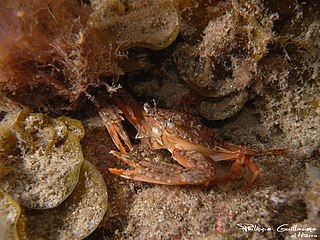
Portunus is a genus of crabs which includes several important species for fisheries, such as the blue swimming crab and the Gazami crab. Other species, such as the three-spotted crab are caught as bycatch.
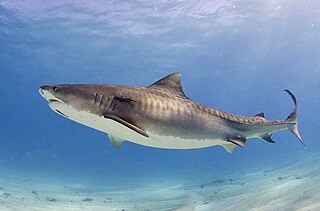
Galeocerdo is a genus of ground shark. Only a single species, G. cuvier, the tiger shark is extant. The earliest fossils date back to the early Eocene epoch, (Ypresian), around 56–47.8 Million years ago. While historically considered a member of the requiem shark family Carcharhinidae, it is currently considered to be the only member of the family Galeocerdonidae. While this genus was historically considered diverse, including 21 extinct species, morphometric analysis conducted in 2021 suggested that the diversity of the genus included only 5 extinct species much lower than previously assumed. The oldest fossils of the extant G. cuvier date to the middle Miocene.
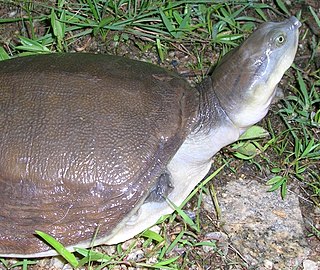
Lissemys is a genus of softshell turtles in the subfamily Cyclanorbinae of the family Trionychidae. The genus is indigenous to southern Asia.

Epihippus is an extinct genus of the modern horse family Equidae that lived in the Eocene, from 46 to 38 million years ago.

Lunaspis is an extinct genus of armor-plated petalichthyid placoderm fish that lived in shallow marine environments of the Early Devonian period, from approximately 409.1 to 402.5 million year ago. Fossils have been found in Germany, China and Australia. There are three different identified species of within the genus Lunaspis: L. broilii, L. heroldi, and L. prumiensis.

Euryzygoma is an extinct genus of marsupial which inhabited humid eucalyptus forests in Queensland and New South Wales during the Pliocene of Australia. Euryzygoma is believed to have weighed around 500 kg, and differed from other diprotodonts in having unusual, flaring cheekbones that may have been used either for storing food or for sexual display. Euryzygoma is thought to be the ancestral genus from which Diprotodon evolved.

Stegolophodon is an extinct genus of stegodontid proboscideans. It lived during the Miocene epoch in Asia. The earliest fossils are known from the Early Miocene, with one of the oldest fossils being from Japan, estimated to be 17.3 million years old. It is suggested to be the ancestor of Stegodon, and transitional fossils between the two genera known from the Late Miocene of Southeast Asia and Yunnan in South China. Like modern elephants, Stegolophodon developed proal jaw movement, where the lower jaw moves in a back-to-front motion, rather than the oblique chewing motion used by earlier proboscideans, with this development already present by 17.3 million years ago. Members of the genus generally have tetralophodont molars, and retain tusks on the lower jaw. The upper tusks have an enamel band.
Gonioglyptus is an extinct genus of trematosaurian temnospondyl within the family Trematosauridae. It is known from the Early Triassic Panchet Formation of India. It contains two species: G. longirostris and G. fragilis. The species G. kokeni from Pakistan has since been reclassified into Aphaneramma.
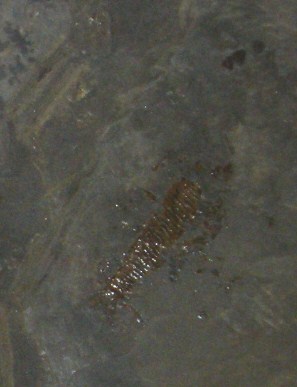
Habroichthys is an extinct genus of prehistoric bony fish that lived during the early Ladinian stage of the Middle Triassic epoch, 242 to 232 million years ago. It has been found in Austria, China, Italy, Slovenia, and Switzerland. It was a small fish measuring 26 cm (10 in) long.
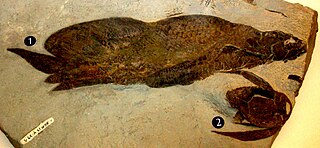
Scaumenacia is an extinct genus of prehistoric lungfish. It lived around the Devonian in North America alongside another prehistoric lungfish: Fleurantia. It lived from approximately 384 to 376 millions of years ago.

Chelonoidis is a genus of turtles in the tortoise family erected by Leopold Fitzinger in 1835. They are found in South America and the Galápagos Islands, and formerly had a wide distribution in the West Indies.

Baenidae is an extinct family of paracryptodiran turtles known from the Early Cretaceous to Eocene of North America. While during the Early Cretaceous they are found across North America, during the Late Cretaceous they are only found in Laramidia, having disappeared from Appalachia. The majority of lineages survived the K-Pg Extinction, but the family was extinct by the latest Eocene. The name of the type genus, Baena, appears to be of Native American origin. They are primarily found in freshwater deposits, and are considered to be aquatic, with a largely generalist habit.

Leptadapis is a genus of adapiform primate that lived in Europe during the middle Eocene. Fossils of the genus have been found in the Escanilla Formation of Spain and Egerkingen in Switzerland.

Boreostemma is an extinct genus of glyptodonts from northern South America. Fossils assigned to the genus were first described as belonging to Asterostemma from southern South America, but have been placed in the new genus Boreostemma by Carlini et al. in 2008. The type species is B. pliocena. Fossils of Boreostemma have been found in the Honda Group of Colombia, in Peru and Venezuela.
Araiochelys is an extinct genus of bothremydid pleurodiran turtle that was discovered in the Ouled Abdoun Basin, Morocco. The genus consists solely of type species A. hirayamai.

Thanatosdrakon is a genus of quetzalcoatline azhdarchid pterosaur from the Late Cretaceous Plottier Formation of the Neuquén Basin in western Argentina. The genus name is derived from the Greek words thanatos (=death) and drakon (=dragon), while the specific name is a Quechuan word meaning "flying serpent" and refers to the Incan deity Amaru. The type and only species is Thanatosdrakon amaru, known from two specimens consisting of several well-preserved axial and appendicular bones including material previously undescribed in giant azhdarchids. Thanatosdrakon is one of the oldest known members of the Quetzalcoatlinae. T. amaru lived from about 90 to 86 million years ago.
Megadolodus is an extinct genus of proterotheriid litopterns.
Jurassonurus is an extinct insect genus of mayflies (Ephemeroptera). This genus has only one member and that member has been scientifically named Jurassonurus amoenus which lived during the Middle Jurassic period 164.7 million to 155.7 million years ago in the Jiulongshan formation, Daohugou Village, Shantou Township, Ningcheng country, Inner mongolia, China.
Sperrgebietomeryx is a genus of girraffoid ruminants that lived during the early and middle Miocene epoch during the Cenozoic era in Namibia about 23.03 million to 15.97 million years ago.
Panolax is an extinct genus of North American Leporid mammal that lived during the Cenozoic era during the Neogene period in the Miocene epoch, about 13.6 million to 10.3 million years ago. The genus has one sole species which is Panolax sanctaefidei. The species lives in North America and only been found in the United States, specifically California and New Mexico. P. scanctaefidei feed on insects species making it a insectivore, a organism that has a diet of primarily insects, arthropods and other similar species.












